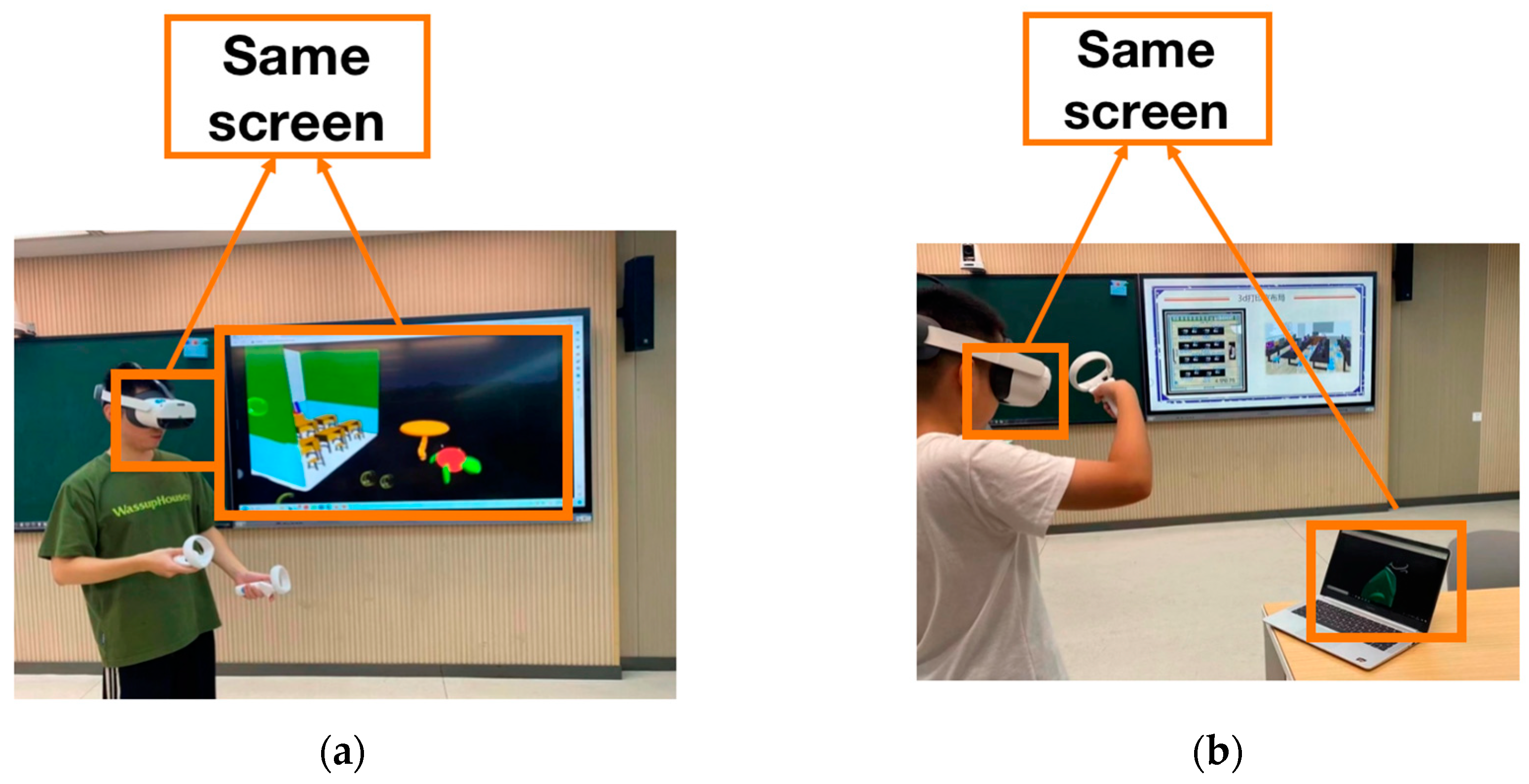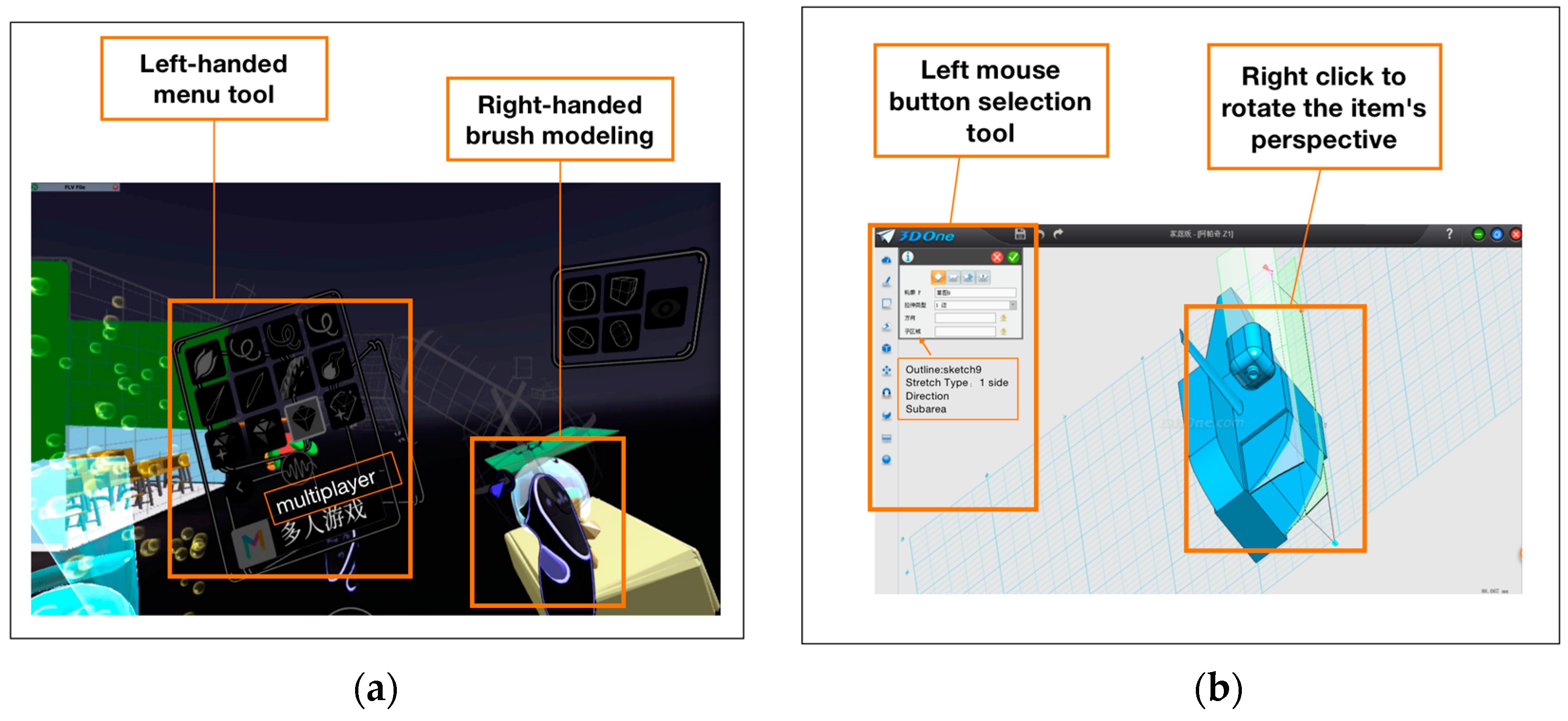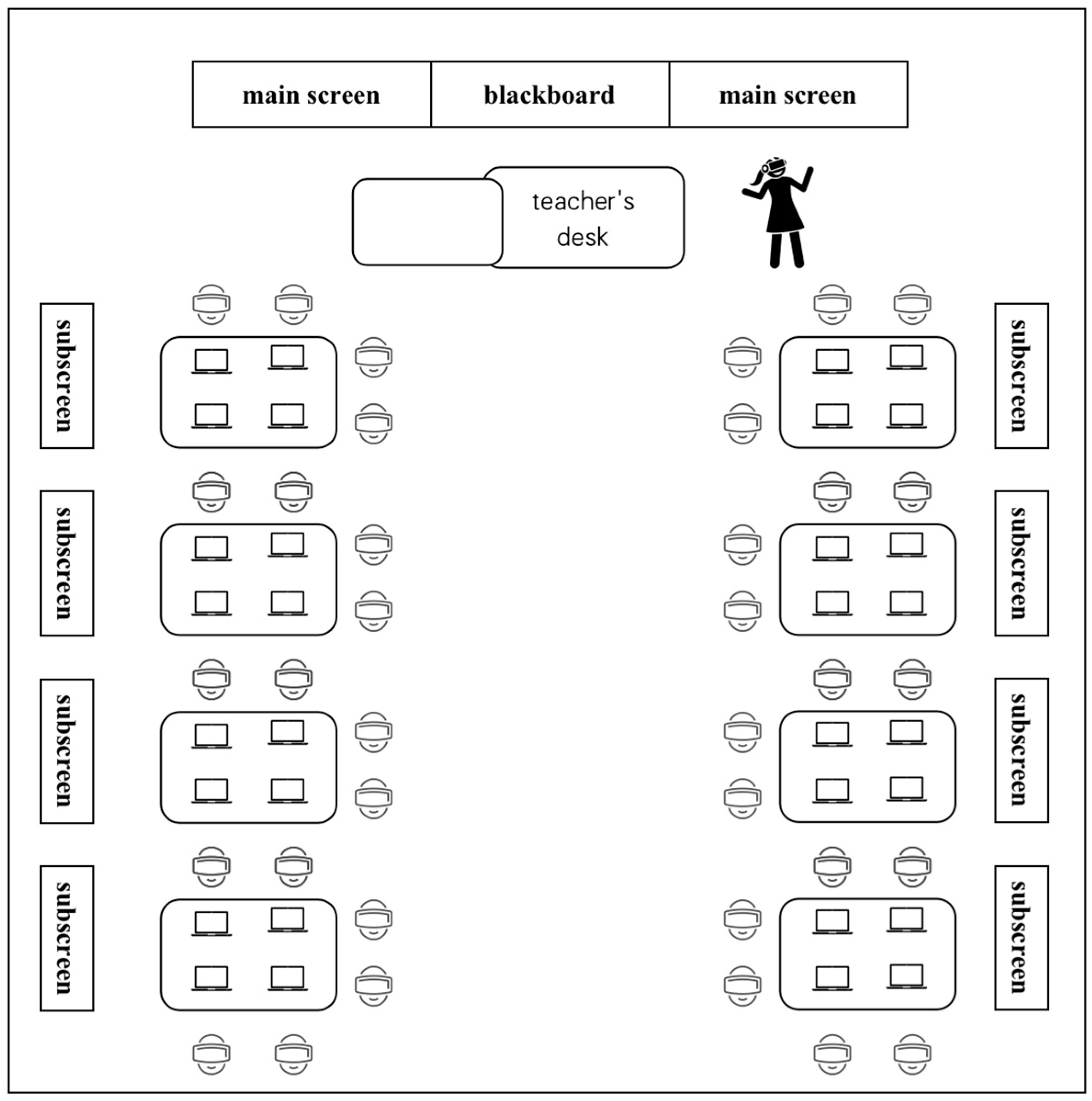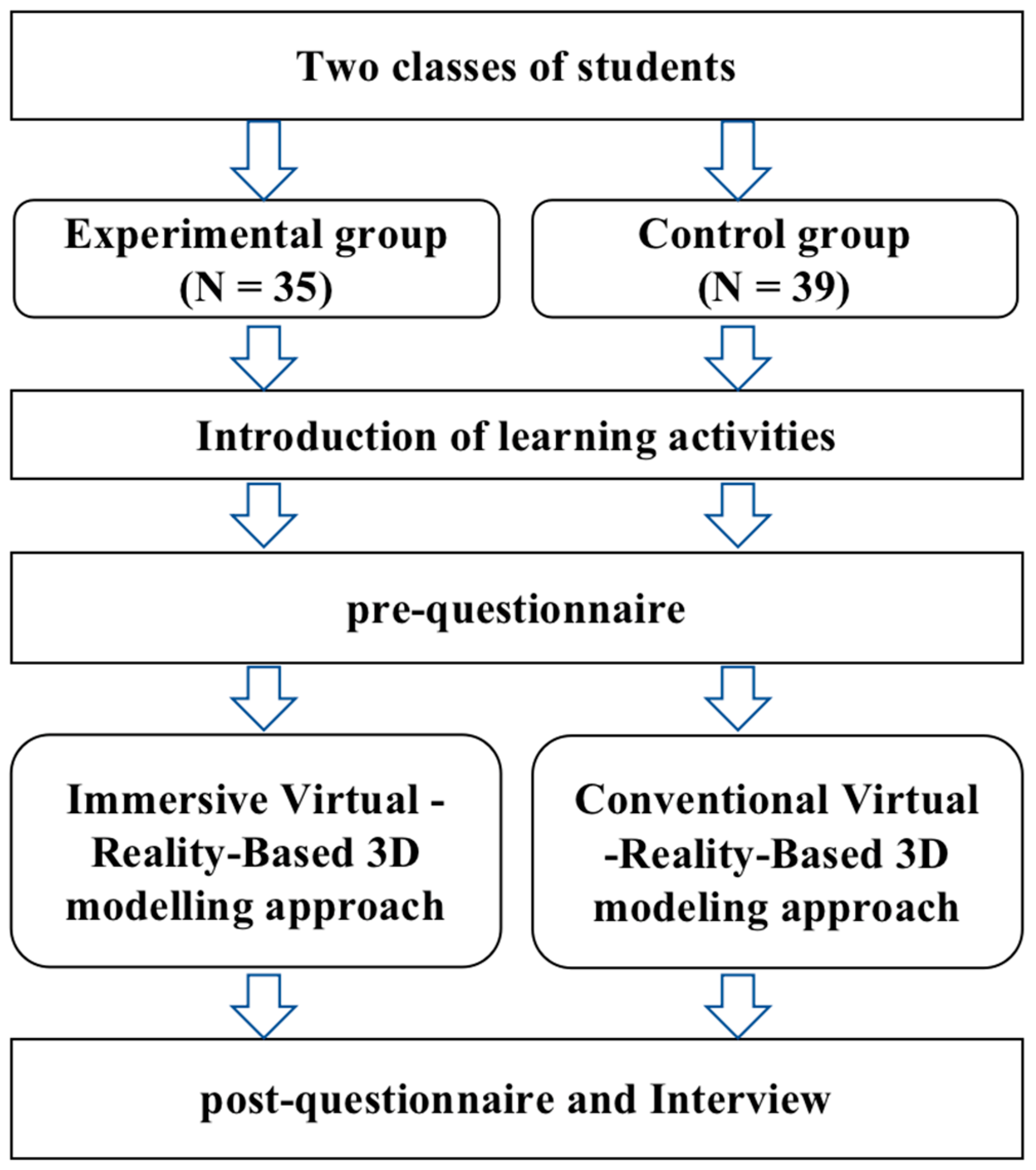The Effects of an Immersive Virtual-Reality-Based 3D Modeling Approach on the Creativity and Problem-Solving Tendency of Elementary School Students
Abstract
1. Introduction
- Can the IVR-based 3D modeling approach improve students’ creative thinking in comparison with the conventional virtual 3D modeling (CVR-based 3D modeling) approach?
- Can the IVR-based 3D modeling approach improve students’ problem-solving tendency in comparison with the conventional virtual 3D modeling (CVR-based 3D modeling) approach?
- Can the IVR-based 3D modeling approach reduce students’ cognitive load in comparison with the conventional virtual 3D modeling (CVR-based 3D modeling) approach?
- What are the students’ feedback and suggestions regarding the use of the IVR-based 3D modeling approach?
2. Literature Review
2.1. Creative Thinking and Problem-Solving Skills in Basic Education
2.2. Virtual 3D Modeling in Education
2.3. Immersive Virtual Reality in Education
2.4. Embodied Cognition and Immersive Virtual Reality
3. An Immersive Virtual-Reality-Based 3D Modeling Approach
4. Methods
4.1. Participants
4.2. Procedure
4.3. Experimental Tools
4.3.1. Experimental Environment
4.3.2. Instruments
4.4. Data Analysis Methods
5. Results
5.1. Analysis of the Students’ Creative Thinking
5.2. Analysis of the Students’ Problem-Solving Skills Tendency
5.3. Analysis of the Students’ Cognitive Load
5.4. Interview
6. Discussion
7. Conclusions
Author Contributions
Funding
Institutional Review Board Statement
Informed Consent Statement
Data Availability Statement
Acknowledgments
Conflicts of Interest
References
- Ghanizadeh, A.; Al-Hoorie, A.H.; Jahedizadeh, S.; Ghanizadeh, A.; Al-Hoorie, A.H.; Jahedizadeh, S. Higher Order Thinking Skills; Springer: Berlin/Heidelberg, Germany, 2020. [Google Scholar]
- Looi, C.-K.; So, H.-J.; Toh, Y.; Chen, W. The Singapore experience: Synergy of national policy, classroom practice and design research. Int. J. Comput.-Support. Collab. Learn. 2011, 6, 9–37. [Google Scholar] [CrossRef]
- Kong, S.C.; Chan, T.W.; Griffin, P.; Hoppe, U.; Huang, R.; Kinshuk, Looi, C.K.; Milrad, M.; Norris, C.; Nussbaum, M.; Sharples, M. E-learning in School Education in the Coming 10 Years for Developing 21st Century Skills: Critical Research Issues and Policy Implications. J. Educ. Technol. Soc. 2014, 17, 70–78. [Google Scholar]
- Beghetto, R.A.; Kaufman, J.C. Toward a broader conception of creativity: A case for ”mini-c” creativity. Psychol. Aesthet. Creat. Arts 2007, 1, 73. [Google Scholar] [CrossRef]
- Malik, R.S. Educational challenges in 21st century and sustainable development. J. Sustain. Dev. Educ. Res. 2018, 2, 9–20. [Google Scholar] [CrossRef]
- Herrington, J.; Kervin, L. Authentic Learning Supported by Technology: Ten suggestions and cases of integration in classrooms. Educ. Media Int. 2007, 44, 219–236. [Google Scholar] [CrossRef]
- Niiranen, S. Supporting the development of students’ technological understanding in craft and technology education via the learning-by-doing approach. Int. J. Technol. Des. Educ. 2021, 31, 81–93. [Google Scholar] [CrossRef]
- Chaudhuri, S.; Koltun, V. Data-driven suggestions for creativity support in 3D modeling. In Proceedings of the ACM SIGGRAPH Asia 2010 Papers, Seoul, Republic of Korea, 15–18 December 2010; p. 183. [Google Scholar]
- Saorín, J.L.; Melian-Díaz, D.; Bonnet, A.; Carbonell Carrera, C.; Meier, C.; De La Torre-Cantero, J. Makerspace teaching-learning environment to enhance creative competence in engineering students. Think. Ski. Creat. 2017, 23, 188–198. [Google Scholar] [CrossRef]
- Wu, Y.C.; Liao, W.H. Analysis of Learning Patterns and Performance—A Case Study of 3-D Modeling Lessons in the K-12 Classrooms. IEEE Access 2020, 8, 186976–186992. [Google Scholar] [CrossRef]
- Preece, D.; Williams, S.B.; Lam, R.; Weller, R. “Let’s Get Physical”: Advantages of a physical model over 3D computer models and textbooks in learning imaging anatomy. Anat. Sci. Educ. 2013, 6, 216–224. [Google Scholar] [CrossRef]
- Carbonell-Carrera, C.; Saorin, J.L.; Melian-Diaz, D.; de la Torre-Cantero, J. Enhancing Creative Thinking in STEM with 3D CAD Modelling. Sustainability 2019, 11, 6036. [Google Scholar] [CrossRef]
- Paukstelis, P.J. MolPrint3D: Enhanced 3D Printing of Ball-and-Stick Molecular Models. J. Chem. Educ. 2018, 95, 169–172. [Google Scholar] [CrossRef]
- Dahle, R.; Rasel, R. 3-D printing as an effective educational tool for MEMS design and fabrication. IEEE Trans. Educ. 2016, 59, 210–215. [Google Scholar] [CrossRef]
- Letnikova, G.; Xu, N. Academic library innovation through 3D printing services. Libr. Manag. 2017, 38, 208–218. [Google Scholar] [CrossRef]
- Chien, Y.-H.; Chu, P.-Y. The Different Learning Outcomes of High School and College Students on a 3D-Printing STEAM Engineering Design Curriculum. Int. J. Sci. Math. Educ. 2018, 16, 1047–1064. [Google Scholar] [CrossRef]
- Ibrahim, R.; Pour Rahimian, F. Comparison of CAD and manual sketching tools for teaching architectural design. Autom. Constr. 2010, 19, 978–987. [Google Scholar] [CrossRef]
- Bowman, D.A.; McMahan, R.P. Virtual reality: How much immersion is enough? Computer 2007, 40, 36–43. [Google Scholar] [CrossRef]
- Meyer, O.A.; Omdahl, M.K.; Makransky, G. Investigating the effect of pre-training when learning through immersive virtual reality and video: A media and methods experiment. Comput. Educ. 2019, 140, 103603. [Google Scholar] [CrossRef]
- Bhattacharjee, D.; Paul, A.; Kim, J.H.; Karthigaikumar, P. An immersive learning model using evolutionary learning. Comput. Electr. Eng. 2018, 65, 236–249. [Google Scholar] [CrossRef]
- Dalgarno, B.; Lee, M.J. What are the learning affordances of 3-D virtual environments? Br. J. Educ. Technol. 2010, 41, 10–32. [Google Scholar] [CrossRef]
- Lee, J.H.; Yang, E.K.; Sun, Z.Y. Design Cognitive Actions Stimulating Creativity in the VR Design Environment. In Proceedings of the 2019 on Creativity and Cognition, San Diego, CA, USA, 23–26 June 2019; pp. 604–611. [Google Scholar]
- Halabi, O. Immersive virtual reality to enforce teaching in engineering education. Multimed. Tools Appl. 2020, 79, 2987–3004. [Google Scholar] [CrossRef]
- Lamb, R.; Antonenko, P.; Etopio, E.; Seccia, A. Comparison of virtual reality and hands on activities in science education via functional near infrared spectroscopy. Comput. Educ. 2018, 124, 14–26. [Google Scholar] [CrossRef]
- Radianti, J.; Majchrzak, T.A.; Fromm, J.; Wohlgenannt, I. A systematic review of immersive virtual reality applications for higher education: Design elements, lessons learned, and research agenda. Comput. Educ. 2020, 147, 103778. [Google Scholar] [CrossRef]
- Runco, M.A.; Jaeger, G.J. The Standard Definition of Creativity. Creat. Res. J. 2012, 24, 92–96. [Google Scholar] [CrossRef]
- Resnick, M.; Rosenbaum, E. Designing for tinkerability. In Design, Make, Play; Routledge: London, UK, 2013; pp. 181–199. [Google Scholar]
- Lin, Y.-J.; Wang, H.-C. Using virtual reality to facilitate learners’ creative self-efficacy and intrinsic motivation in an EFL classroom. Educ. Inf. Technol. 2021, 26, 4487–4505. [Google Scholar] [CrossRef]
- Fan, X.; Zhong, X. Artificial intelligence-based creative thinking skill analysis model using human–computer interaction in art design teaching. Comput. Electr. Eng. 2022, 100, 107957. [Google Scholar] [CrossRef]
- Hsia, L.-H.; Lin, Y.-N.; Hwang, G.-J. A creative problem solving-based flipped learning strategy for promoting students’ performing creativity, skills and tendencies of creative thinking and collaboration. Br. J. Educ. Technol. 2021, 52, 1771–1787. [Google Scholar] [CrossRef]
- Guaman-Quintanilla, S.; Everaert, P.; Chiluiza, K.; Valcke, M. Impact of design thinking in higher education: A multi-actor perspective on problem solving and creativity. Int. J. Technol. Des. Educ. 2023, 33, 217–240. [Google Scholar] [CrossRef]
- Treffinger, D.J. Creative Problem Solving: Overview and educational implications. Educ. Psychol. Rev. 1995, 7, 301–312. [Google Scholar] [CrossRef]
- Xu, W.; Geng, F.; Wang, L. Relations of computational thinking to reasoning ability and creative thinking in young children: Mediating role of arithmetic fluency. Think. Ski. Creat. 2022, 44, 101041. [Google Scholar] [CrossRef]
- Wu, J.; Guo, R.; Wang, Z.; Zeng, R. Integrating spherical video-based virtual reality into elementary school students’ scientific inquiry instruction: Effects on their problem-solving performance. Interact. Learn. Environ. 2021, 29, 496–509. [Google Scholar] [CrossRef]
- Huang, S.-Y.; Kuo, Y.-H.; Chen, H.-C. Applying digital escape rooms infused with science teaching in elementary school: Learning performance, learning motivation, and problem-solving ability. Think. Ski. Creat. 2020, 37, 100681. [Google Scholar] [CrossRef]
- Quan, H.; Zhang, T.; Xu, H.; Luo, S.; Nie, J.; Zhu, X. Photo-curing 3D printing technique and its challenges. Bioact. Mater. 2020, 5, 110–115. [Google Scholar] [CrossRef]
- Oner, A.; Nite, S.; Capraro, M.; Capraro, R. The effect of 3D design on students’ belief about “A” of STEAM. In Proceedings of the Annual Meeting of Southwest Educational Research Association, San Antonio, TX, USA, 12–14 February 2015. [Google Scholar]
- Paul, S. 3D Printed Manipulatives in a Multivariable Calculus Classroom. PRIMUS 2018, 28, 821–834. [Google Scholar] [CrossRef]
- Gao, W.; Zhang, Y.; Ramanujan, D.; Ramani, K.; Chen, Y.; Williams, C.B.; Wang, C.C.L.; Shin, Y.C.; Zhang, S.; Zavattieri, P.D. The status, challenges, and future of additive manufacturing in engineering. Comput.-Aided Des. 2015, 69, 65–89. [Google Scholar] [CrossRef]
- Hatzigianni, M.; Stevenson, M.; Bower, M.; Falloon, G.; Forbes, A. Children’s views on making and designing. Eur. Early Child. Educ. Res. J. 2020, 28, 286–300. [Google Scholar] [CrossRef]
- Sullivan, P.; McCartney, H. Integrating 3D printing into an early childhood teacher preparation course: Reflections on practice. J. Early Child. Teach. Educ. 2017, 38, 39–51. [Google Scholar] [CrossRef]
- Bicer, A.; Nite, S.B.; Capraro, R.M.; Barroso, L.R.; Capraro, M.M.; Lee, Y. Moving from STEM to STEAM: The effects of informal STEM learning on students’ creativity and problem solving skills with 3D printing. In Proceedings of the 2017 IEEE Frontiers in Education Conference (FIE), Indianapolis, IN, USA, 18–21 October 2017; pp. 1–6. [Google Scholar]
- Wang, D.D.; Qian, Z.; Vukicevic, M.; Engelhardt, S.; Kheradvar, A.; Zhang, C.; Little, S.H.; Verjans, J.; Comaniciu, D.; O’Neill, W.W.; et al. 3D Printing, Computational Modeling, and Artificial Intelligence for Structural Heart Disease. JACC Cardiovasc. Imaging 2021, 14, 41–60. [Google Scholar] [CrossRef]
- Guan, J.-Q.; Wang, L.-H.; Chen, Q.; Jin, K.; Hwang, G.-J. Effects of a virtual reality-based pottery making approach on junior high school students’ creativity and learning engagement. Interact. Learn. Environ. 2023, 31, 2016–2032. [Google Scholar] [CrossRef]
- Biocca, F.; Delaney, B. Immersive virtual reality technology. Commun. Age Virtual Real. 1995, 15, 10–5555. [Google Scholar]
- Ryan, M.-L. Narrative as Virtual Reality 2: Revisiting Immersion and Interactivity in Literature and Electronic Media; JHU Press: Baltimore, MD, USA, 2015. [Google Scholar]
- Makransky, G.; Andreasen, N.K.; Baceviciute, S.; Mayer, R.E. Immersive virtual reality increases liking but not learning with a science simulation and generative learning strategies promote learning in immersive virtual reality. J. Educ. Psychol. 2021, 113, 719. [Google Scholar] [CrossRef]
- Makransky, G.; Petersen, G.B. The Cognitive Affective Model of Immersive Learning (CAMIL): A Theoretical Research-Based Model of Learning in Immersive Virtual Reality. Educ. Psychol. Rev. 2021, 33, 937–958. [Google Scholar] [CrossRef]
- Chiu, M.C.; Hwang, G.J.; Hsia, L.H. Promoting students’ artwork appreciation: An experiential learning-based virtual reality approach. Br. J. Educ. Technol. 2023, 54, 603–621. [Google Scholar] [CrossRef]
- Ghaednia, H.; Fourman, M.S.; Lans, A.; Detels, K.; Dijkstra, H.; Lloyd, S.; Sweeney, A.; Oosterhoff, J.H.; Schwab, J.H. Augmented and virtual reality in spine surgery, current applications and future potentials. Spine J. 2021, 21, 1617–1625. [Google Scholar] [CrossRef] [PubMed]
- Schiopu, A.F.; Hornoiu, R.I.; Padurean, A.M.; Nica, A.-M. Constrained and virtually traveling? Exploring the effect of travel constraints on intention to use virtual reality in tourism. Technol. Soc. 2022, 71, 102091. [Google Scholar] [CrossRef]
- Di Natale, A.F.; Repetto, C.; Riva, G.; Villani, D. Immersive virtual reality in K-12 and higher education: A 10-year systematic review of empirical research. Br. J. Educ. Technol. 2020, 51, 2006–2033. [Google Scholar] [CrossRef]
- Ekstrand, C.; Jamal, A.; Nguyen, R.; Kudryk, A.; Mann, J.; Mendez, I. Immersive and interactive virtual reality to improve learning and retention of neuroanatomy in medical students: A randomized controlled study. CMAJ Open 2018, 6, E103. [Google Scholar] [CrossRef] [PubMed]
- Merchant, Z.; Goetz, E.T.; Cifuentes, L.; Keeney-Kennicutt, W.; Davis, T.J. Effectiveness of virtual reality-based instruction on students’ learning outcomes in K-12 and higher education: A meta-analysis. Comput. Educ. 2014, 70, 29–40. [Google Scholar] [CrossRef]
- Chang, H.; Park, J.; Suh, J. Virtual reality as a pedagogical tool: An experimental study of English learner in lower elementary grades. Educ. Inf. Technol. 2024, 29, 4809–4842. [Google Scholar] [CrossRef]
- Baukal, C.E.; Ausburn, F.B.; Ausburn, L.J. A proposed multimedia cone of abstraction: Updating a classic instructional design theory. J. Educ. Technol. 2013, 9, 15–24. [Google Scholar] [CrossRef][Green Version]
- Concannon, B.J.; Esmail, S.; Roduta Roberts, M. Head-mounted display virtual reality in post-secondary education and skill training. Proc. Front. Educ. 2019, 4, 80. [Google Scholar] [CrossRef]
- Conrad, M.; Kablitz, D.; Schumann, S. Learning effectiveness of immersive virtual reality in education and training: A systematic review of findings. Comput. Educ. X Real. 2024, 4, 100053. [Google Scholar] [CrossRef]
- Parong, J.; Mayer, R.E. Cognitive and affective processes for learning science in immersive virtual reality. J. Comput. Assist. Learn. 2021, 37, 226–241. [Google Scholar] [CrossRef]
- Stepan, K.; Zeiger, J.; Hanchuk, S.; Del Signore, A.; Shrivastava, R.; Govindaraj, S.; Iloreta, A. Immersive virtual reality as a teaching tool for neuroanatomy. Proc. Int. Forum Allergy Rhinol. 2017, 7, 1006–1013. [Google Scholar] [CrossRef] [PubMed]
- Wilson, M. Six views of embodied cognition. Psychon. Bull. Rev. 2002, 9, 625–636. [Google Scholar] [CrossRef] [PubMed]
- Esrock, E.J. Embodying art: The spectator and the inner body. Poet. Today 2010, 31, 217–250. [Google Scholar] [CrossRef]
- Repetto, C.; Serino, S.; Macedonia, M.; Riva, G. Virtual Reality as an Embodied Tool to Enhance Episodic Memory in Elderly. Front. Psychol. 2016, 7, 1839. [Google Scholar] [CrossRef]
- Sinnamon, C.; Miller, E. Architectural concept design process impacted by body and movement. Int. J. Technol. Des. Educ. 2022, 32, 1079–1102. [Google Scholar] [CrossRef]
- Poulsen, S.B.; Thøgersen, U. Embodied design thinking: A phenomenological perspective. CoDesign 2011, 7, 29–44. [Google Scholar] [CrossRef]
- Kang, S.; Norooz, L.; Bonsignore, E.; Byrne, V.; Clegg, T.; Froehlich, J.E. Prototypar: Prototyping and simulating complex systems with paper craft and augmented reality. In Proceedings of the 18th ACM International Conference on Interaction Design and Children, Boise, ID, USA, 12–15 June 2019; pp. 253–266. [Google Scholar]
- Ratcliffe, J.; Tokarchuk, L. Evidence for embodied cognition in immersive virtual environments using a second language learning environment. In Proceedings of the 2020 IEEE Conference on Games (CoG), Osaka, Japan, 24–27 August 2020; pp. 471–478. [Google Scholar]
- Chang, Y.-S.; Kao, J.-Y.; Wang, Y.-Y. Influences of virtual reality on design creativity and design thinking. Think. Ski. Creat. 2022, 46, 101127. [Google Scholar] [CrossRef]
- Yang, X.; Lin, L.; Cheng, P.-Y.; Yang, X.; Ren, Y.; Huang, Y.-M. Examining creativity through a virtual reality support system. Educ. Technol. Res. Dev. 2018, 66, 1231–1254. [Google Scholar] [CrossRef]
- Lin, C.; Wang, M. The Creativity Assessment Packet; Psychological Publishing: Taipei, Taiwan, 1994. [Google Scholar]
- Chen, S.; Wang, Q.; Wang, X.; Huang, L.; Zhang, D.; Shi, B. Self-determination in Physical Exercise Predicts Creative Personality of College Students: The Moderating Role of Positive Affect. Front. Sports Act. Living 2022, 4, 926243. [Google Scholar] [CrossRef]
- Lai, C.L.; Hwang, G.J. Effects of mobile learning time on students’ conception of collaboration, communication, complex problem–solving, meta–cognitive awareness and creativity. Int. J. Mob. Learn. Organ. 2014, 8, 276–291. [Google Scholar] [CrossRef]
- Hwang, G.-J.; Yang, L.-H.; Wang, S.-Y. A concept map-embedded educational computer game for improving students’ learning performance in natural science courses. Comput. Educ. 2013, 69, 121–130. [Google Scholar] [CrossRef]
- Hwang, G.-J.; Yang, T.-C.; Tsai, C.-C.; Yang, S.J. A context-aware ubiquitous learning environment for conducting complex science experiments. Comput. Educ. 2009, 53, 402–413. [Google Scholar] [CrossRef]
- Cohen, J. Statistical Power Analysis for the Behavioral Sciences; Academic Press: Cambridge, MA, USA, 2013. [Google Scholar]
- Alatta, R.A.; Freewan, A. Investigating the effect of employing immersive virtual environment on enhancing spatial perception within design process. ArchNet-IJAR Int. J. Archit. Res. 2017, 11, 219. [Google Scholar] [CrossRef]
- Scurati, G.W.; Bertoni, M.; Graziosi, S.; Ferrise, F. Exploring the Use of Virtual Reality to Support Environmentally Sustainable Behavior: A Framework to Design Experiences. Sustainability 2021, 13, 943. [Google Scholar] [CrossRef]
- Liu, H.; Wang, Z.; Mazumdar, A.; Mousas, C. Virtual reality game level layout design for real environment constraints. Graph. Vis. Comput. 2021, 4, 200020. [Google Scholar] [CrossRef]
- Tano, S.; Kodera, T.; Nakashima, T.; Kawano, I.; Nakanishi, K.; Hamagishi, G.; Inoue, M.; Watanabe, A.; Okamoto, T.; Kawagoe, K. Godzilla: Seamless 2D and 3D sketch environment for reflective and creative design work. In Proceedings of the INTERACT’03, Zurich, Switzerland, 1–5 September 2003; pp. 311–318. [Google Scholar]
- Özgen, D.S.; Afacan, Y.; Sürer, E. Usability of virtual reality for basic design education: A comparative study with paper-based design. Int. J. Technol. Des. Educ. 2021, 31, 357–377. [Google Scholar] [CrossRef]
- Stefanou, C.R.; Perencevich, K.C.; DiCintio, M.; Turner, J.C. Supporting autonomy in the classroom: Ways teachers encourage student decision making and ownership. Educ. Psychol. 2004, 39, 97–110. [Google Scholar] [CrossRef]
- Richman, W.L.; Kiesler, S.; Weisband, S.; Drasgow, F. A meta-analytic study of social desirability distortion in computer-administered questionnaires, traditional questionnaires, and interviews. J. Appl. Psychol. 1999, 84, 754. [Google Scholar] [CrossRef]
- Tastan, H.; Tuker, C.; Tong, T. Using handheld user interface and direct manipulation for architectural modeling in immersive virtual reality: An exploratory study. Comput. Appl. Eng. Educ. 2022, 30, 415–434. [Google Scholar] [CrossRef]
- Makransky, G.; Borre-Gude, S.; Mayer, R.E. Motivational and cognitive benefits of training in immersive virtual reality based on multiple assessments. J. Comput. Assist. Learn. 2019, 35, 691–707. [Google Scholar] [CrossRef]
- Chen, Y.-C.; Chang, Y.-S.; Chuang, M.-J. Virtual reality application influences cognitive load-mediated creativity components and creative performance in engineering design. J. Comput. Assist. Learn. 2022, 38, 6–18. [Google Scholar] [CrossRef]
- Larmuseau, C.; Cornelis, J.; Lancieri, L.; Desmet, P.; Depaepe, F. Multimodal learning analytics to investigate cognitive load during online problem solving. Br. J. Educ. Technol. 2020, 51, 1548–1562. [Google Scholar] [CrossRef]
- Pouw, W.T.J.L.; van Gog, T.; Paas, F. An Embedded and Embodied Cognition Review of Instructional Manipulatives. Educ. Psychol. Rev. 2014, 26, 51–72. [Google Scholar] [CrossRef]
- Fogarty, J.; McCormick, J.; El-Tawil, S. Improving student understanding of complex spatial arrangements with virtual reality. J. Prof. Issues Eng. Educ. Pract. 2018, 144, 04017013. [Google Scholar] [CrossRef]





| Dimension | Group | N | Mean | SD | t |
|---|---|---|---|---|---|
| Risk Taking | Experimental group | 35 | 2.03 | 0.33 | −0.12 |
| Control group | 39 | 2.04 | 0.31 | ||
| Curiosity | Experimental group | 35 | 2.18 | 0.33 | 1.88 |
| Control group | 39 | 2.03 | 0.35 | ||
| Imagination | Experimental group | 35 | 2.05 | 0.34 | 1.66 |
| Control group | 39 | 1.93 | 0.29 | ||
| Challenge | Experimental group | 35 | 2.13 | 0.30 | 1.32 |
| Control group | 39 | 2.03 | 0.37 |
| Sub-Dimensions | Group | N | Mean | SD | F | p | η2 |
|---|---|---|---|---|---|---|---|
| Risk Taking | Experimental | 35 | 2.19 | 0.28 | 1.41 | 0.239 | 0.02 |
| Control | 39 | 2.10 | 0.33 | ||||
| Curiosity | Experimental | 35 | 2.42 | 0.26 | 7.95 | 0.006 * | 0.099 |
| Control | 39 | 2.20 | 0.39 | ||||
| Imagination | Experimental | 35 | 2.57 | 0.35 | 7.78 | 0.007 * | 0.097 |
| Control | 39 | 2.35 | 0.34 | ||||
| Challenge | Experimental | 35 | 2.43 | 0.29 | 8.40 | 0.005 * | 0.104 |
| Control | 39 | 2.23 | 0.31 |
| Group | N | Mean | SD | Adjusted Mean | F(1,71) | η2 |
|---|---|---|---|---|---|---|
| Experimental group | 35 | 3.94 | 0.40 | 3.90 | 10.05 ** | 0.124 |
| Control group | 39 | 3.58 | 0.62 | 3.62 |
| Dimension | Group | N | Mean | SD | t | d |
|---|---|---|---|---|---|---|
| Cognitive load | Experimental group | 35 | 2.60 | 0.55 | −2.71 ** | −0.632 |
| Control group | 39 | 3.00 | 0.69 | |||
| Mental load | Experimental group | 35 | 2.33 | 0.55 | −2.33 * | −0.542 |
| Control group | 39 | 2.67 | 0.67 | |||
| Mental efforts | Experimental group | 35 | 2.87 | 0.60 | −2.77 ** | −0.645 |
| Control group | 39 | 3.32 | 0.80 |
| Theme | Theme Code | The Number of Occurrences | |
|---|---|---|---|
| IVR-3D | CVR-3D | ||
| Advantages | More intuitive and natural | 6· | 3 |
| Interesting and amusing | 6 | 5 | |
| Immersive | 5 | 2 | |
| Understanding design shapes | 3 | 4 | |
| Drawbacks | Discomfort | 5 | 0 |
| Lack of operational precision | 6 | 2 | |
| Lack of guidance | 4 | 4 | |
| Unfriendly interface | 0 | 6 | |
| Student Gains | Problem-solving skills | 4 | 5 |
| Creative expression | 4 | 2 | |
| Spatial capability | 7 | 2 | |
Disclaimer/Publisher’s Note: The statements, opinions and data contained in all publications are solely those of the individual author(s) and contributor(s) and not of MDPI and/or the editor(s). MDPI and/or the editor(s) disclaim responsibility for any injury to people or property resulting from any ideas, methods, instructions or products referred to in the content. |
© 2024 by the authors. Licensee MDPI, Basel, Switzerland. This article is an open access article distributed under the terms and conditions of the Creative Commons Attribution (CC BY) license (https://creativecommons.org/licenses/by/4.0/).
Share and Cite
Chen, S.-J.; Chen, C.-Q.; Shan, X.-F. The Effects of an Immersive Virtual-Reality-Based 3D Modeling Approach on the Creativity and Problem-Solving Tendency of Elementary School Students. Sustainability 2024, 16, 4092. https://doi.org/10.3390/su16104092
Chen S-J, Chen C-Q, Shan X-F. The Effects of an Immersive Virtual-Reality-Based 3D Modeling Approach on the Creativity and Problem-Solving Tendency of Elementary School Students. Sustainability. 2024; 16(10):4092. https://doi.org/10.3390/su16104092
Chicago/Turabian StyleChen, Shu-Jie, Chuang-Qi Chen, and Xiao-Fen Shan. 2024. "The Effects of an Immersive Virtual-Reality-Based 3D Modeling Approach on the Creativity and Problem-Solving Tendency of Elementary School Students" Sustainability 16, no. 10: 4092. https://doi.org/10.3390/su16104092
APA StyleChen, S.-J., Chen, C.-Q., & Shan, X.-F. (2024). The Effects of an Immersive Virtual-Reality-Based 3D Modeling Approach on the Creativity and Problem-Solving Tendency of Elementary School Students. Sustainability, 16(10), 4092. https://doi.org/10.3390/su16104092







